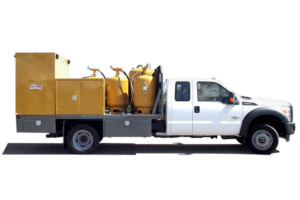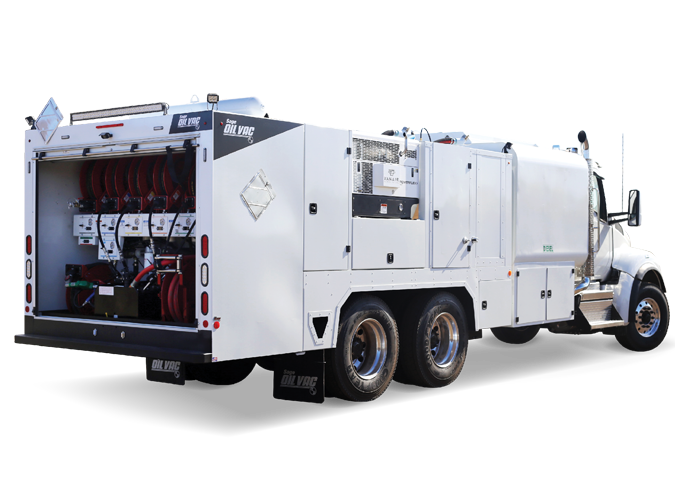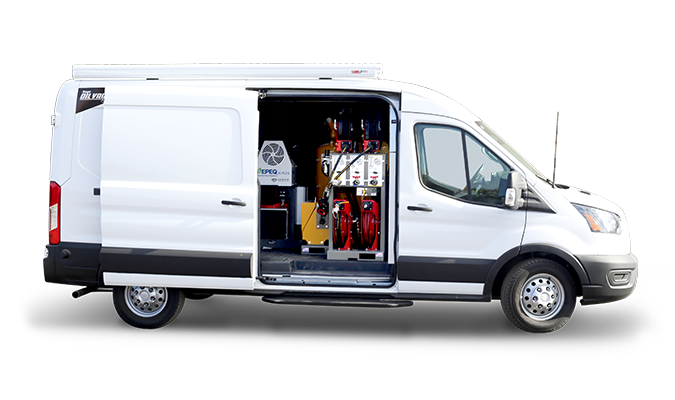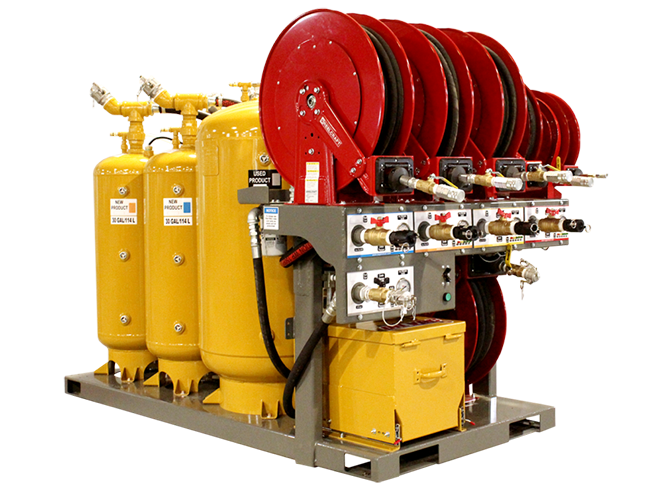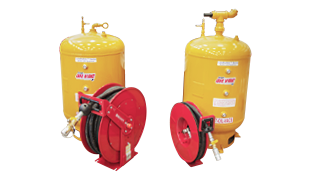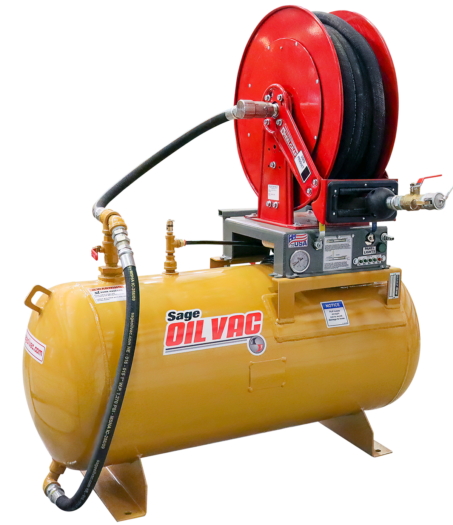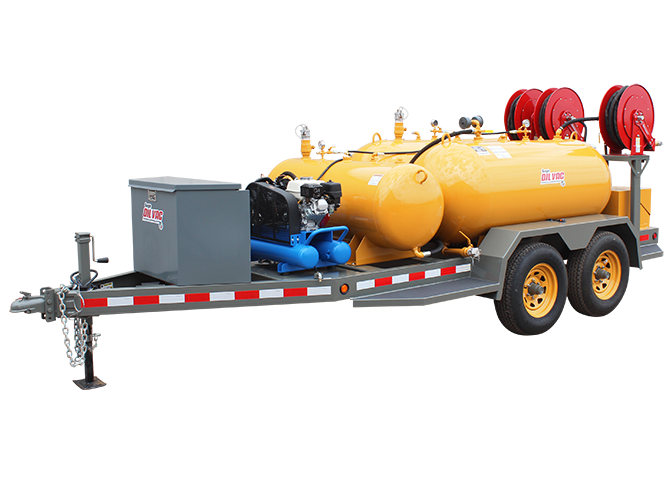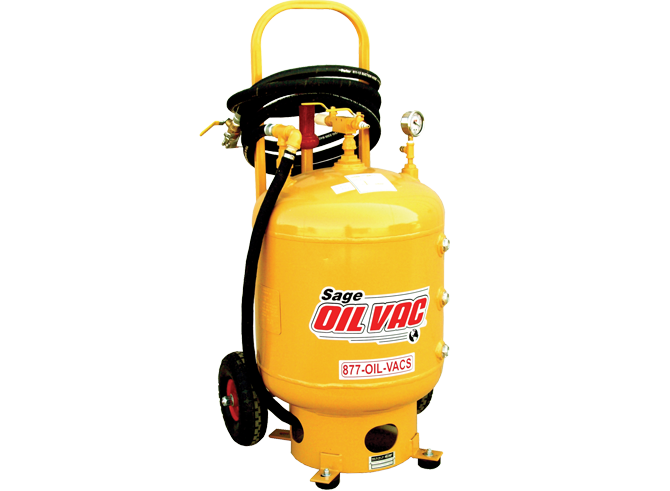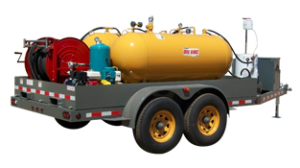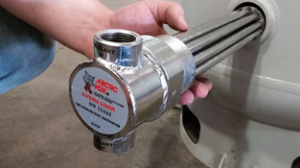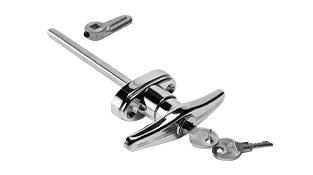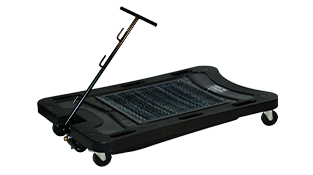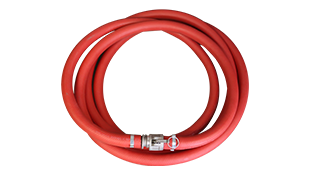When you think of lube trucks, you probably picture a large Class 7 or Class 8 tandem-axle truck. They’ve long been the norm on jobsites around the country. These trucks are large enough to include fuel and lube combinations but can also be high-capacity lube-only options.
While Class 7 and Class 8 trucks are a great fit for many operations, crews that don’t need to transport fuel or DEF might find more compact truck bodies to be a better fit. In fact, more contractors, dealers and rental companies are choosing non-CDL (commercial driver’s license) service trucks with GVWRs (gross vehicle weight ratings) up to 26,000 pounds — thanks to the cost and efficiency benefits. And with open and enclosed body options, there’s a fit for every kind of work environment. Let’s take a look.
Why pros choose non-CDL service trucks
1. No CDL required
Anyone who operates a lube truck that weighs more than 26,000 pounds needs a valid CDL. And it’s no secret certified drivers are in high demand and short supply. Weighing in at no more than 26,000 pounds, a non-CDL service truck doesn’t require a commercial operator — which means adding one to your fleet significantly expands your potential labor pool.
2. Easy to navigate
A single-axle non-CDL service truck offers enhanced maneuverability on crowded jobsites. These lighter-weight trucks can also perform better in rough terrain than larger tandem-axle trucks. The Chevrolet 6500, Ford F-600 and International 6500 currently available as Sage Oil Vac non-CDL trucks are all four-wheel drive. This adds mobility seldom seen with a larger truck.
In these instances, the non-CDL service truck can be more productive than a larger lube truck. If you travel between jobsites and encounter difficult terrain, a smaller truck may be your best choice.
3. Built for efficiency
Depending on the applications you use a service truck for, a non-CDL service truck may operate more efficiently. For instance, smaller displacement engines consume less fuel when driving long distances between jobsites.
Sage Oil Vac pump-free vacuum technology adds to that efficiency. The system pulls oil quickly from the equipment without any moving parts. An enclosed, non-vented system protects the operator and the environment — helping eliminate spills. Clean, sealed tanks also mean fewer contaminants are introduced into fresh fluids, while the pump-free system translates into faster exchanges and a lower cost of ownership.
4. Equipped with the operator in mind
Choosing a smaller service truck doesn’t mean you have to compromise on features. Non-CDL Sage Oil Vac lube bodies have everything you need, plus all the bells and whistles.
Start by choosing either an open or enclosed model. Open lube trucks are a great fit for milder climates, while enclosed lube trucks can handle cold conditions for year-round flexibility. Either way, you’ll find plenty of capacity for fluids and more than 60 cubic feet of storage space to stock up on essential parts and tools for your next job.
Operators can easily view fluid levels with LED indicators and make changes with centrally located controls — both available in the fluid reels cabinet. Make changing oil filters cleaner than ever with the Sage Oil Vac Filter Stinger™, an exclusive accessory designed to pierce and drain used oil filters. Those filters can then be placed in the Used Filter Receptacle™ to let the rest of the oil drip into a tray so operators can quickly vacuum it into a designated tank with the turn of a valve. Finally, keep your tool storage organized with a five-drawer mechanics drawer set.
5. Less up-front investment
Bigger isn’t always better. A non-CDL lube truck offers an economical option for preventive maintenance for operations that can’t utilize the full capacity of a larger truck. Calculate the total weight of the products you’ll carry to help assess your needs before automatically sizing up your next truck. You could have a lower upfront cost with a smaller truck. Add lower utilization costs without wasted extra capacity to that and you get a higher return on your investment.
Finding the right solution for your operation
There’s no one-size-fits-all lube truck. Jobsite maneuverability, the upfront investment, utilization and the ability to find drivers all play critical roles in sizing the best lube truck for your application. Contact Sage Oil Vac to determine which truck is right for you — or start by checking out our tips on finding the right lube truck for your needs.
Have you identified the need for a better mobile lube solution but feel your fleet is too small for a dedicated lube truck or trailer? We hear this all the time. Turn your mechanic truck, service van, flatbed truck or trailer into a mobile service solution with a mobile lube skid – and realize cleaner, faster and safer fluid exchanges.
Advantages of a mobile lube skid.
Budget is an important consideration for any new maintenance solution. Mobile lube skids nicely balance lower entry investment that still provides expanded capabilities to traditional fluid exchange methods. One reason they’re more economical is because they can be added to an existing vehicle.
Portability is another huge advantage. Mobile lube skids are compact with easy-access forklift slots and sling lifting rings. They can be moved between vehicles, jobsites, and your shop with a crane or fork truck. You can even place them out of the way when you don’t need to use them.
Fresh fluids? Used fluids? Both? Mobile lube skids also offer versatility to fit the needs of your operation, including the amount of product tanks you need and capacity from 30-60 gallons.
Finally, mobile skids offer nearly unmatched flexibility. Because they can be taken in and out of vehicles, you still have full access to your truck or van. You still have access to your trailer hitch when hauling your skid.
Perhaps most importantly, mobile lube skids ensure your maintenance program can carry on even if your truck breaks down. Just move the skid to a new vehicle.
“Old-fashioned” buckets and funnels versus mobile lube skid simplicity
When performing an oil change there are two common scenarios. One is the messy, antiquated practice of using buckets and funnels. Technicians spending hours on the ritual of removing oil plugs, catching the oil in a container and using a funnel to replace it with new oil. It’s physically demanding and comes with plenty of oil spill risks.
The other option is a mobile lube skid designed to help technicians finish oil changes without any additional equipment. It’s faster, cleaner and less physically demanding. That translates to happier employees and a better ROI.
Why Sage Oil Vac mobile lube skids stand out
Sage Oil Vac lube skids offer lower initial investment, portability, flexibility and lowest cost to own — with the added advantage of exclusive pump-free technology. Our pump-free vacuum technology uses compressed air to move fluids into and out of tanks. A Sage Oil Vac system can vacuum fill fresh oil tanks at rates up to 15 gallons per minute, dispense products at rates of up to 5 gallons a minute and vacuum hot motor oil at up to 6 to 8 gallons per minute. The result? More machines serviced daily than mechanical pump-driven models. And no pumps mean less long-term maintenance on the system itself.
The pump-free process uses sealed non vented tanks, which also means oil changes with Sage Oil Vac are cleaner and safer. Contaminants stay in the tanks, rather than spill into the environment or on the technician.
“We started with one small Sage Oil Vac lube skid and when we saw how much more efficient it was than the old way we serviced machines in the field, we added additional units until we had enough to service our whole fleet.”
– Trey Villanueva
Operations manager for equipment rentals
Big D Companies
Need a custom system? We have you covered.
Technicians are more productive when they have all the fluids they need to service the fleet without the added stress of frequent trips to the shop. Sometimes there’s not a one-size-fits-all solution for what your operation requires in a mobile lube system. Sage Oil Vac offers an industry-unique solution with the LubeBuilder™ system, which also features the exclusive patented no-pump lube exchange technology.
As a completely customizable, à la carte kit, the LubeBuilder system cuts costs by allowing you to select the configuration you need for a more economic upfit. You’ll work with the Sage Oil Vac team to customize everything from the number of tanks to tank storage capacities, placement of tanks, and more.
“The Sage Oil Vac LubeBuilder system helped elevate our operation to a more professional level. We have become a better provider in all areas of the business. PM can be performed much faster than before. Technicians are much happier because of the cleanliness of the system. They don’t have to clean up a jobsite after doing a PM when they head home at the end of the day. It helps with hiring and retention of employees.”
Patrick Connell
President and CEO
ARS Truck & Fleet Service
Mobile lube skids fit applications for every size company — even large fleets. A skid can easily service a few pieces of equipment brought to a jobsite before the bulk of the work begins or those left on site once work is finished for the day.
Contact a Sage Oil Vac dealer to discuss how a lube skid can increase oil change efficiency for your operation — or explore our available inventory to see the skids available to ship right now.
Pump-free fluid exchange systems aren’t the industry standard (even though they’re faster, cleaner and safer than pump-based systems). That means we’ve run into some interesting ideas about Sage Oil Vac systems and how they work. Today, we’re busting the three most common misconceptions.
How Sage Oil Vac systems work
First, here’s a quick refresher on how our exclusive Sage Oil Vac vacuum technology works.
Our patented pump-free systems are designed for faster, cleaner and safer fluid exchanges. The not-so-secret secret is vacuum pressure, created with compressed air. This pressure allows operators to move fluids to and from tanks in an enclosed system. That means fewer spills on the job — all while saving time. Sage Oil Vac equipment can vacuum fill fresh oil tanks at a rate of up to 15 gallons per minute. Hot motor oil can be vacuumed up at 6 to 8 gallons per minute.
So why aren’t pump-free systems the top choice for all preventive maintenance pros? Because not everyone has heard the difference they can make on the job. We’re ready to set the record straight.
Myth No. 1
Sage Oil Vac systems require more air compressor run time than pump-based equipment.
It may seem hard to believe with all our talk of building vacuum pressure, but pump-free fluid exchange systems use less compressor run time than pump-based equipment.
Conventional air pump systems need to run air compressors 100% of the time to maintain performance in the field. With Sage Oil Vac equipment, you only need to run the compressor until you have the necessary pressure to drain or dispense fluids. Operators should turn off machines once 20 inches (50.8 cm) of vacuum has been captured in the waste tank and 60-80 fluid pressure per square inch (psi) in the fresh oil tank. If they do, Sage Oil Vac systems can reduce air compressor run time by up to 70% over conventional pump-based equipment.
You also have options with our equipment. Pressurize your tanks in the shop with compressors before you leave or on the jobsite with a gas- or diesel-powered air compressor. We have models that match the needs of every operation — not to mention custom setup offerings.
Myth No. 2
Sage Oil Vac systems are louder than pump-based equipment.
Remember when we said you can turn off the compressor once you’ve built enough pressure? That means less noise on the job, potentially reducing work-day fatigue for your crew members. Using the air compressor is good for your equipment too, helping minimize wear and tear on your equipment. Sounds like a win-win.
Myth No. 3
Sage Oil Vac systems require more pressure than pump-based equipment.
Traditional equipment uses waves of pressure to extract and dispense fluids. Sage Oil Vac systems use stored vacuum in the tank to powerfully collect fluids, then use stored pressure to efficiently dispense fluids. As a result, our systems use less cfm.
Just the facts
After all that myth-busting, let’s take a look at some of the important truths about Sage Oil Vac systems. Here are four reasons that maintenance crews choose pump-free fluid exchange systems.
- They’re cleaner. Clean, sealed tanks mean fewer contaminants are introduced into fresh fluids — not to mention how pump-free systems can reduce spills on the job.
- They’re safer. Our enclosed, no-pump system protects the operator and the environment, as tanks are not vented to the atmosphere.
- They’re faster. A Sage Oil Vac system can vacuum fill fresh oil tanks at rates up to 15 gallons per minute, dispense products at rates of up to 5 gallons a minute and vacuum hot motor oil at up to 6 to 8 gallons per minute.
- They help maximize equipment ROI. No pumps mean fewer maintenance issues — and that means a lower overall cost of ownership.
Ready to make the switch? Get in touch for a free quote.
It’s no secret that consumers have grown accustomed to the convenience of home delivery services. Just look outside. You can probably spot an Amazon, DoorDash or even local grocery store delivery right now.
Automotive maintenance is starting to enter the delivery category with mobile oil change services. This industry is primed for strong growth, leaving a unique opportunity for fleet maintenance companies.
Let’s put this into perspective. In 2023, IBISWorld reported oil changes in the U.S. generated $10.6 billion in revenue — and they predict growth through 2029. Mobile oil changes are set to disrupt the automotive fleet maintenance industry with convenient service performed in the customer’s driveway, garage or parking lot. Not only does this save valuable time for vehicle owners, but it also keeps automotive and commercial fleet customers on the road, maximizing uptime and profits.
With that in mind, we’re breaking down a few reasons to consider expanding into automotive fleet maintenance.
Consistent consumer and industry demand
The mobile oil change service is insulated from market swings. Despite economic fluctuations that impact automotive sales, the demand for critical maintenance tasks, such as oil changes, remains constant. According to Entrepreneur magazine, there are over 130 million vehicles registered in the United States. Each one needs oil and lubrication replacement at some point. Assuming an oil change is performed every 5,000 miles, that means 390 million oil changes are performed each year.
Low barriers to entry
Compared to other industries, the mobile oil change business comes with a low cost of entry. However, selecting the right tools can help set your business up for success. Look for equipment that minimizes the chance of spills, offers the appropriate capacity and is easy to transport.
The VacBuilt system by Sage Oil Vac was created to meet all those needs, filling an important gap in the market. This equipment lineup provides ready-to-use mobile oil change service solutions with 30- or 60-gallon waste oil tanks. A single waste oil collection solution with a hose reel and controls can capture fluids from different vehicles utilizing different types and grades of oil.
“Mobile service is gaining popularity in the automotive world. Getting used oil out of the vehicle is the most important part of that oil change. A 30- or 60-gallon capacity system, like the VacBuilt, will handle many oil changes on passenger vehicles. Preassembled, ready-to-roll equipment like this is a good initial investment for a company that wants to get into that business,” says Aaron Sage, Sage Oil Vac CEO.
A clean, efficient solution
VacBuilt systems provide all the benefits of Sage Oil Vac’s pump-free vacuum technology with additional configuration flexibility. The systems will easily fit in the bed of a truck or the back of a van for customers performing mobile lube services. The vacuum generator includes a push-on fitting at the air inlet to simplify operation. Pressurize the VacBuilt system with your own compressed air source to build vacuum pressure to move fluids to and from tanks. The operator can then remove hot motor oil from equipment at up to six to eight gallons per minute.
The enclosed, pump-free system also protects the operator and the environment as tanks are not vented to the atmosphere. And no pumps also mean fewer maintenance problems for a lower cost of ownership.
So, if you’re looking to expand into the auto mobile fleet maintenance, a VacBuilt system might just be what you need to get started.
Contact Sage Oil Vac for a free quote and learn how a VacBuilt system can help set you up for success.
Sage Oil Vac is unveiling the latest innovation in its mobile lube equipment lineup at the 2023 SEMA Show. The new VacBuilt system by Sage Oil Vac provides ready-to-use mobile service solutions. The first offering in the lineup is a waste oil tank, providing flexibility for service technicians who don’t require a new bulk oil tank when completing preventive maintenance on vehicles and heavy equipment. A single waste oil collection solution can capture fluids from a mix of different vehicles utilizing different types and grades of oil.
This VacBuilt product combines a 30- or 60-gallon horizontal used oil tank with mounting options for a hose reel and controls. A removable mounting plate provides flexibility to either mount a hose reel and controls to the top of the tank or they can be mounted remotely, depending on the most effective configuration for the application.
This initial product offering features tank capacities well suited to meet the demands of both mobile automotive fleet service and heavy equipment applications.
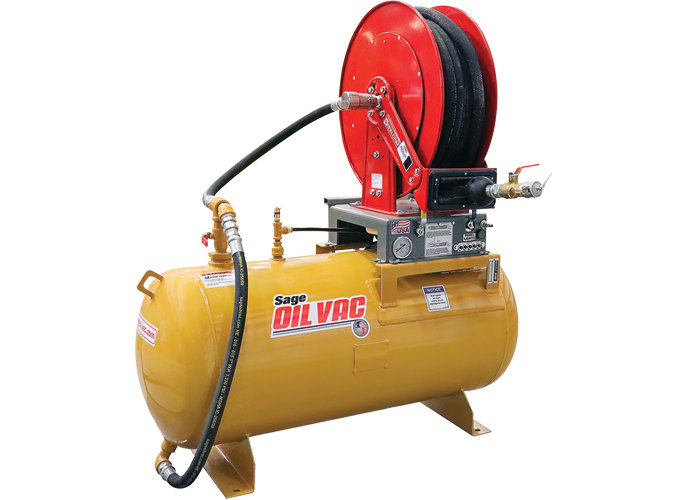 “Mobile service is gaining popularity in the automotive world. Getting used oil out of the vehicle is the most important part of that oil change. A 30-gallon or 60-gallon capacity will handle many oil changes on passenger vehicles. It is a good initial investment for a company that wants to get into that business,” says Aaron Sage, Sage Oil Vac CEO.
“Mobile service is gaining popularity in the automotive world. Getting used oil out of the vehicle is the most important part of that oil change. A 30-gallon or 60-gallon capacity will handle many oil changes on passenger vehicles. It is a good initial investment for a company that wants to get into that business,” says Aaron Sage, Sage Oil Vac CEO.
Sage Oil Vac plans to expand the VacBuilt line with larger-capacity tanks in the future as it continues to innovate products based on its proven pump-free technology. These fluid exchange systems are fast, safe, clean, economical and versatile. Clean, sealed tanks protect the operator and the environment, reducing spills.
Packaged for convenience
A single used-oil tank solution has always been available through Sage Oil Vac’s LubeBuilder™ program. However, the product line required customers order the desired components and assemble the system themselves. To meet the emerging demand, VacBuilt systems are now assembled at the factory for customer convenience and to ensure product quality.
“With this used oil solution, it is ready to go. We have taken a common specification and packaged it together. Just hook your air source to it,” said Sage.
The addition of two brackets welded to the top of the used oil tank allows the control panel and hose reel to be mounted on the system. The control panel includes a pressure gauge, a ball valve with a pressure relief setting and a ball valve with a vacuum setting. Customers can choose between a one-inch by 50-foot hose reel or a 3/4-inch by 25-foot hose reel.
The Sage advantage
The vacuum-generator-operated VacBuilt provides all the benefits of Sage Oil Vac’s no-pump vacuum technology with additional configuration flexibility. The vacuum generator includes a push-on fitting at the air inlet to simplify operation. Compressed air is used to build vacuum pressure to move fluids to and from tanks. The operator can vacuum hot motor oil from equipment at up to six to eight gallons per minute.
The enclosed, no-pump system protects the operator and the environment as tanks are not vented to the atmosphere. The exclusion of pumps also means fewer maintenance problems for a lower cost of ownership.
Adaptable for the shop or truck
VacBuilt is suitable for both mobile and shop applications. In the shop, these used oil tanks eliminate the need for centralized lube systems that are expensive to install within a building and have extensive upkeep.
These tanks will also easily fit in the bed of a truck for customers performing mobile lube services. They are a good starting point for customers exploring the growing automotive mobile oil change business.
Based in Newcastle, Delaware, ARS Truck & Fleet Service thrives on providing exceptional mobile fleet service, keeping customers’ vehicles moving through preventive maintenance and repair services — working both in the shop and on the road. It’s even been named one of Delaware’s Fastest 50 growing companies and the Multi-Shop Organization top shop by the Automotive Training Institute. Even with all the recognition and a packed schedule of 50,000 services annually, customer relationships remain the focal point of the business.
“We’re the best at what we do because we understand there’s real people behind the wheel, real businesses trying to succeed and real customer’s we’re trying to support,” said Patrick Connell, president and CEO of ARS Truck & Fleet Service.
ARS Truck & Fleet Service prioritizes a win-win relationship with its customer base. Customers can count on the company to handle preventive maintenance, allowing them to focus completely on their operations. This keeps vehicles operating efficiently and saves costs over time with more efficient operation, less downtime and longer equipment life.
ARS Truck & Fleet Service attributes its high level of success to attracting the best employees and partnering with the best equipment suppliers. Its highly trained crews use custom mobile lube equipment from Sage Oil Vac to complete fast, safe and clean fluid exchanges.
Customized equipment meets unique mobile fleet servicing needs
ARS Truck & Fleet Service provides onsite and in-shop preventive maintenance for fleets ranging from five to 500 vehicles in Delaware, Maryland, Pennsylvania and New Jersey. The company’s mobile fleet services keep customers on the road, eliminating the need to ferry vehicles back and forth. Service solutions are customized to meet the unique needs of each customer.
In the same way, ARS Truck & Fleet Service leadership didn’t want a pre-packaged preventive maintenance equipment solution when investing in updated lube trucks. They needed the flexibility to design a tailored solution. The company found an ideal partner with Sage Oil Vac. The revolutionary Sage Oil Vac LubeBuilder™ system provides a customizable à la carte solution featuring patented no-pump lube exchange technology. Quick response times confirmed the Sage Oil Vac team was just as customer focused as ARS Fleet Service.
“Sage Oil Vac responded in record time. ARS Truck & Fleet Service was well down the road to buying Sage Oil Vac equipment before any other lube system providers even called back,” recalled Connell.
The Sage Oil Vac lineup ranges from lube carts to trucks to fit a range of needs — including completely customizable LubeBuilder systems. Working with Sage Oil Vac, the ARS Truck & Fleet Service team was able to develop a solution uniquely tailored to meet the needs of its customers as well as on-site and mobile fleet service technicians.
The result of the collaborative design process was a LubeBuilder system mounted in enclosed high-roof utility bodies. The systems are equipped with two tanks — one waste oil tank and one fresh oil tank. Light-duty trucks use 30-gallon tanks while heavy-duty trucks use 60-gallon tanks.
Located along the Atlantic coast, ARS Truck & Fleet Service faces hot summers and cold winters with an average of 45 inches of precipitation annually. But the enclosed Sage Oil Vac lube trucks are up to the challenge. No amount of cold has stopped them.
Many features have been added to simplify efficiency for the service technician. For example, LED product-level sensors are being used. The technician knows how much capacity is left in the tank without guessing.
Exceeding customer expectations
To raise the bar for its customers, ARS Truck & Fleet Service needed to find a solution that would address customary limitations of competitive preventive maintenance solutions. So, they chose a mobile lube equipment partner who does things differently.
“Sage Oil Vac is uniquely positioned to attack many different issues with one piece of equipment,” said Connell.
That includes speeding — and cleaning — up preventive maintenance. ARS Truck & Fleet Service can now change oil faster and with less mess than the competition. The patented Sage Oil Vac system uses cutting-edge vacuum technology to make changing fluids faster, while the enclosed design keeps oil where it should be. Compressed air builds vacuum pressure to move fluids to and from tanks making mobile fleet servicing cleaner than ever.
“The Sage Oil Vac system helped elevate ARS Truck & Fleet Service to a more professional level. We have become a better provider in all areas of the business. PM can be performed much faster than before. Technicians are much happier because of the cleanliness of the system. They don’t have to clean up a jobsite after doing a PM when they head home at the end of the day. It helps with hiring and retention of employees,” said Connell.
“We listened to ARS Truck & Fleet Service and adapted our product to meet their unique needs. This is a partnership built on a desire to deliver top-notch customer service,” said Aaron Sage, CEO of Sage Oil Vac.
ARS Truck & Fleet Service has been able to up its game by specifying custom preventive maintenance trucks with the Sage Oil Vac LubeBuilder system. This partnership has proven a true win-win relationship, with ARS Fleet Service budgeting for over 20 more LubeBuilder systems in the first half of next year.
Sage Oil can customize a solution that addresses the unique needs of any preventive maintenance application. Use the Sage Oil Vac Product Match Tool to discover the best system for your work.
If plummeting temperatures stress you out, just imagine what they do to your equipment and field service technicians. While changing oil in cold weather is necessary, it can take a toll on both people and machines. Working in subzero conditions quickly induces fatigue. And as the mercury drops, oil thickens and equipment becomes more reluctant to turn over due to the increased oil friction resistance and decreased battery efficiency.
However, delaying preventive maintenance is not a successful strategy. Don’t wait for freezing temperatures to catch you out in the cold. Be prepared with the right procedures, fluids and equipment to keep your machines and technicians productive. We’ve broken down our top tips for changing oil in cold weather.
Keep the oil flowing
Oil viscosity is the key differentiator in cold-weather operations. It measures the resistance of the oil to flow at different temperatures — ultimately determining the thickness or thinness of the oil. This is perhaps one of the most important properties of oil because viscosity provides the lubrication film between metal parts. The viscosity needs to be thick enough to prevent metal contact while being thin enough to prevent excessive energy loss.
Temperature changes can influence oil viscosity, which makes changing oil in cold weather more difficult. You’ll need the right oil to match the conditions. The oil must remain sufficiently viscous at high temperatures, but it can’t be too thick at low temperatures. The oil must remain robust across a wide temperature range to handle cold starts in the winter and normal internal operating temperatures.
When selecting the appropriate oil, pay particular attention to the number before the W in the oil specification. That number stands for the winter viscosity. A lower number means it is more fluid at a colder temperature. For instance, a 5W-40 engine oil is thinner in cold temperatures than a 10W-30.
Since viscosity is dependent on temperature, consult the equipment owner’s manual and make sure you are using the recommended oil for the temperatures you will be operating in. Equipment operator manuals may suggest different oils for varying temperature ranges.
Changing oil in cold weather
Never perform ‘cold’ oil changes, regardless of the weather outside. Best practice dictates oil should always be warm so it flows freely and drains completely. Start the engine to circulate the oil prior to the oil change or perform the oil change shortly after the equipment has been shut down for the day.
Running the engine immediately prior to an oil change also helps ensure better removal of contaminants from inside the engine. When the machine is working, contaminants from wear, the combustion process and the environment are suspended in the oil.
Shortly after shutting the machine down, these contaminants settle out to internal surfaces and the bottom of the oil pan. If you change the oil after the engine has been at rest, these contaminants will likely adhere to the internal engine surfaces.
Get a leg up on the competition
Why not just bring the equipment to a heated shop where technicians can work in comfort? While this sounds like a logical solution for changing oil in cold weather, there are several drawbacks to consider. When equipment is integral to a jobsite’s overall operation, the time and cost to transport equipment to the shop and back results in lost productivity. This can quickly erode revenue potential.
It is often simply more cost-effective to service equipment on the jobsite, even during the cold weather months. Sage Oil Vac can help you find solutions that will give you a leg up on the competition while protecting vital assets — your technicians and your equipment.
Make it easier for technicians
Working long hours to finish changing oil in cold weather can be unbearable with a subpar lube truck setup. Using buckets to change the oil further complicates the task and exposes technicians to hot oil. Having the right tools for the job makes all the difference.
Using a closed-loop system with quick disconnects protects your technicians from oil exposure and reduces manual effort while your technicians battle the weather. Less physical effort in subzero temperatures means more productive technicians.
The Sage Oil Vac system reduces the effort required by your technicians. It uses compressed air to build air pressure and move fluids to and from tanks. Hot motor oil can be vacuumed from equipment at up to six to eight gallons per minute. This enclosed, no-pump system with sealed tanks protects both the operator and the environment from spills.
Options for enclosed trailers, enclosed trucks or even a custom system can also simplify changing oil in cold weather. Sage Oil Vac offers heated fluid tanks that use immersion heaters to help promote productivity. Coolant circulates through probes in the tank, transferring heat to the oil and enabling easier oil changes as outside temperatures plummet.
Sage Oil Vac also offers an optional heated grease probe. This allows the technician to heat grease and improve flow rates in cold weather months.
Make it easier for your technicians. Contact Sage Oil Vac and get prepared for any weather.
Finding drivers and navigating tight urban jobsites requires an innovative approach.
BY AARON SAGE
The long-standing driver shortage continues to worsen while many contractors also face ever more crowded urban jobsites. These challenges place a squeeze on existing mobile lube activities.
Large Class 7 or Class 8 lube/fuel trucks have been the norm on jobsites around the U.S. for decades. These trucks help technicians maximize preventive maintenance efficiency by transporting large quantities of off-road diesel and oil. Technicians can service multiple machines in the field before returning to the shop for additional fluids.
The capacity of these trucks depends on the Gross Vehicle Weight Rating (GVWR), which defines the maximum legal weight of a vehicle including passengers and cargo. The GVWR helps determine how many gallons of fluid a lube truck can transport. It’s not uncommon for Class 7 or Class 8 lube/fuel trucks to haul up to 1,000 gallons of fuel and 400 gallons of maintenance fluids in one trip.
While the capacity provides a clear advantage for some applications, Class 7 and larger trucks exceeding 26,000 pounds GVWR requires operators with commercial driver’s license (CDL). With these drivers becoming harder to find, some lube truck owners are exploring smaller trucks that don’t require a CDL — those in Class 5 and Class 6 — to help them care for equipment on the job. In the process, they’re discovering the cost and efficiency benefits of deploying these smaller open- and enclosed non-CDL trucks that weren’t frequently seen on jobsites just a few years ago.
Cope with the driver shortage
The first factor driving the transition to non-CDL trucks is the worsening driver shortage. Despite growing demand for all types of commercial transportation that requires a CDL — namely over-the-road trucking — the number of licensed commercial drivers in the U.S. has not increased. In short, the demand is growing but the qualified labor pool is not. There’s just a shortage of qualified, skilled drivers. It’s as simple as that.
This places lube truck owners in direct competition with over-the-road haulers and local businesses. You can invest over a month sending your employee to a driver school to earn a CDL, but there is no guarantee that you can retain that driver to recoup the investment.
Sprint Sand and Clay specializes in dirt work and selling construction materials to contractors and home builders in Greater Houston, Texas. When it comes to operating lube trucks for preventive maintenance, they find drivers with a CDL can demand higher compensation. It is also difficult to compete for available drivers because many don’t want to service equipment. They simply want to drive.
“Trying to find a CDL driver that wants to perform the service, not just take a load from point A to point B all day, is tough,” said Jacob Phillips, vice president of operations at Sprint Sand and Clay.
Lube truck owners can proactively address this challenge by eliminating the licensing requirement and creating new opportunities for existing employees. Without the requirement for special licensing, almost any technician in the shop can be assigned to run a non-CDL truck. This opens the door to more hiring opportunities for company owners and managers and more employment opportunities for operators.
Balance capacity and efficiency
The second factor in the transition to non-CDL trucks is the actual fluid capacity needed to service equipment. Contractors simply may not need the capacity or fuel-handling capability of a Class 7 or Class 8 lube truck. While not having enough capacity to service all the equipment on the jobsite leads to a loss of efficiency, hauling excess capacity decreases efficiency as well.
Sprint Sand and Clay knew they needed a solution that would balance capacity with efficiency. When the maintenance staff must service more than 200 pieces of heavy equipment on 35 jobsites across the fourth largest U.S. city, efficiency is essential. That’s the challenge this contractor faces each day. When its lube truck leaves the shop, it may travel two hours one way to a jobsite.
“It’s important that the truck has enough storage and fluid capacity to service many pieces of equipment on that side of town before going back and refilling the truck,” said Kyle Cain, president of Sprint Sand and Clay.
Sprint Sand and Clay’s service technician typically performs preventive maintenance on every piece of equipment while the truck is on a jobsite to maximize efficiency.
“In today’s world, you have to be as efficient as possible. We attribute our success a lot to equipment that we use and the innovation that’s provided with that equipment, from our dump trucks to our equipment to our lube trucks,” said Cain.
Sprint Sand and Clay turned to a Sage Oil Vac non-CDL open lube body. The non-CDL bodies — available in both open and enclosed formats — are perfect for heavy equipment preventive maintenance. The open non-CDL lube body features a 180-gallon (681.37-L) used oil tank and five fresh product tanks with a combined 400-gallon (1,514-L) capacity. The enclosed lube body offers additional protection from the elements and higher fluid capacity — with a 220-gallon (832.8-L) used oil tank, 420 gallons of new oil capacity, 120-pound grease capacity, and 60-gallon tanks for new and used coolant.
“We really believe in the small compact size of a Sage lube truck. It’s very efficient and the cost of ownership compared to having a larger CDL truck with a CDL driver just makes sense,” said Cain.
Despite its compact size, the non-CDL open lube body is up to the task of servicing Sprint Sand and Clay’s 200-machine fleet. It offers the capacity to service all the equipment on up to two jobsites without having to go back to the shop to fill up.
Minimize operating costs
The third factor in the transition to a non-CDL lube truck is the lower operating cost. It is easy to assume a bigger lube truck would drive efficiency, but that’s not always the case. Traditional Class 7 or Class 8 trucks have high fluid capacities, enabling them to service a lot of equipment. However, due to their size, they’re also less fuel efficient when traveling long distances.
If the smaller truck has the capacity to tackle a day’s worth of preventive maintenance without returning to the shop, it may provide a lower cost of operation. For instance, smaller displacement engines consume less fuel when driving long distances between jobsites.
Without wasted extra capacity, utilization costs can decrease. Lower upfront costs paired with a smaller operating cost translate into a higher return on investment. Maintenance staff can calculate the total weight of the products that need to be carried to help assess truck size. It’s not always beneficial to automatically size up the next truck.
There are also regulatory costs to consider when operating larger trucks — which become an even bigger issue when traveling across state lines. Multiple non-CDL trucks will sometimes be more cost-effective and efficient than one Class 8 truck. It’s sometimes hard to get people to make a change like that, but when you put pencil to paper, these changes can pay for themselves in months.
Access tight jobsites
A fourth factor to consider in the transition to a non-CDL lube truck would be jobsite access. Larger tandem-axle trucks can be difficult to maneuver on jobsites with uneven terrain. A single-axle non-CDL service truck offers enhanced maneuverability on tight or crowded jobsites. These lighter-weight trucks can also perform better than larger tandem-axle trucks in rough terrain. Sage Oil Vac uses Chevrolet 6500, Ford F-600 and International 6500 four-wheel drive chassis. This adds mobility seldom seen with a larger truck due to the driven steer axle.
If you’re working at a remote location that has a lot of challenging terrain, the smaller jobsite lube truck is going to be nimbler and will perform better in terrain like that than a larger, tandem-axle truck. This added maneuverability has been beneficial to Sprint Sand and Clay.
“It’s been very easy to maneuver in traffic, especially in Houston,” noted Cain.
Maneuverability coupled with quick connect fillings and design of the Sage Oil Vac system with its sealed tanks reduces the chance of oil spills.
“A lot of our jobs are on government entity property — cities and counties — so being able to get in and out without having any spillage or environmental issues is very important to us,” said Cain.
Consider all alternatives
There are several reasons for transitioning to a non-CDL lube truck. It opens the available labor force, it can reduce operating costs, it is more maneuverable and there is a lower acquisition cost. The latter was particularly important for Sprint Sand and Clay.
The compact size and efficient operation of the non-CDL truck gives Sprint Sand and Clay a cost-effective heavy equipment service option. It provided a more cost-effective solution than relying on the local equipment dealer for preventive maintenance.
“I think when you compare what we would have to pay from the dealership versus doing it ourselves, it just really made sense for us,” said Cain.
But the non-CDL truck is not the best answer for every application. You really need to look at all available options and determine if a larger lube/fuel truck, a trailer or a jobsite skid will work best in your specific application. Each solution has its own unique set of benefits.
* This article was first published in the July issue of Equipment Today magazine.
You’re already aware of how preventive maintenance (PM) programs can help reduce operating costs, increase reliability and extend equipment life. Yet many operations remain stuck in a corrective maintenance rut where they spend much of their time repairing or servicing machines that are down.
While preventive maintenance is a simple concept, developing actual preventive maintenance programs prove more challenging. Where do you start?
Break the process into a few manageable steps.
Set goals
Start by defining what you want to achieve. Are you targeting reduced equipment failures and downtime, decreased maintenance costs or extended equipment life? The answer to this question can help determine how your preventive maintenance program can be structured.
For instance, if your primary goal is to maximize uptime, service speed may be an important element in your preventive maintenance efforts.
“The quicker the PM can be performed, the faster equipment can get back to work. If the maintenance can be performed during off hours, the machine will be ready to go when an operator’s shift starts,” says Aaron Sage, CEO, Sage Oil Vac.
Create an asset list
Preventive maintenance programs require careful documentation. Create a list of all machines in your fleet and their condition. This should include the make, model and serial number for each machine in your preventive maintenance program.
Make a checklist outlining the required maintenance task schedule, including inspections, adjustments and calibrations, and replacement of disposable components for each machine. Include a list of all the fluids, filters and common service parts — as well as quantities — required to perform the maintenance.
In order to coordinate maintenance, you will need a way to track each machine’s location, usage and the maintenance schedule checklist. A tool like a computerized maintenance management system (CMMS) can ensure work is not missed, lost or ignored.
Develop a personalized approach
Identify the optimum maintenance interval for each asset. This can be based on time or usage. Time-based preventive maintenance may occur daily, weekly, monthly, quarterly, semi-annually or annually. Usage-based frequencies can be based on runtime hours or mileage.
Preventive maintenance programs can be structured around a central service shop or mobile jobsite service vehicles. Is it more efficient to bring your equipment to a central service facility or to service equipment on the jobsite? Often servicing equipment on the job saves transportation time and cost, allowing crews to service multiple machines during off hours for maximum utilization.
Choose the right solutions
After your preventive maintenance program is structured, it is time to locate the best service and lube solutions. With numerous options and configurations available, it can be overwhelming to determine which mobile lube equipment is the best fit for your needs.
Fleet size, the distance between jobsites, and fluid types and quantities needed for service all factor into your best fluid maintenance solution. You want to be able to carry all the fluids, filters and components necessary to perform service without multiple trips back to the shop. There isn’t a single solution that meets the needs of every preventive maintenance program. That’s why Sage Oil Vac offers a full line of lube skids, fuel and lube trailers, and lube trucks and bodies. Our expert team can help you identify the best solution for your unique needs.
Fluid exchange speed is another important consideration for many preventive maintenance programs. For example, the Sage Oil Vac pump-free design can fill products at a rate of up to 20 gallons per minute. It can also vacuum hot motor oil from equipment at up to 6 to 8 gallons per minute. That’s much faster than conventional pump-based fluid exchange systems. The time savings translate into more machines serviced per day.
Accuracy can be another important consideration in the selection process. Each Sage Oil Vac mobile lube system offers a digital meter to ensure you fill machines with the proper amount of fluid. Certain meters offer preset functions that allow you to set the amount of oil needed to refill the tank. No more underfilling or overfilling.
Train technicians on the process
In addition to the proper tools, well-designed preventive maintenance programs need without properly trained technicians. These technicians will need to understand the process of capturing and documenting necessary information in the field.
Track and adjust
Lastly, a good preventive maintenance program constantly evolves. Over time, ask yourself: What is working well? What are the pain points? Am I achieving my stated goals? If not, why?
It is necessary to track results and continually adjust the program to meet defined objectives and adapt to evolving business demands.
In summary, the steps to create a successful PM program include:
- Set goals
- Create an asset list
- Identify optimum maintenance intervals
- Choose the right equipment
- Train technicians
- Track and adjust the PM program
It is often helpful to seek outside advice. Sage Oil Vac can help you find solutions to refine your preventive maintenance program.
Let’s face it. Difficulty sourcing new equipment means you will need to ask more from aging fleets. Extending equipment life cycles with proactive maintenance and filling gaps with used machines are common coping strategies to deal with shortages and economic uncertainty.
Despite the end of the COVID-19 pandemic, the construction equipment supply chain is still struggling to find a new normal. Several factors contributed to this crisis. The COVID-19 pandemic disrupted global supply chains, causing production shutdowns, labor shortages and transportation bottlenecks. Manufacturing plants faced temporary closures and reduced capacities, leading to delays in equipment production.
At the same time, the rapid growth of infrastructure projects in emerging economies, such as China and India, significantly increased the demand for construction equipment. Manufacturers struggled to keep up with this heightened demand, making recovery in the supply chain even more difficult.
Continued supply chain constraints are inflating prices for construction equipment, extending project timelines and increasing competition for limited resources. As a result, many businesses have been forced to keep existing machines in the fleet longer, purchase used equipment or rent to fill the gaps.
Gain significant edge with proactive maintenance strategy
But how do you maintain productivity with an aging equipment fleet? The answer lies in stepping up proactive maintenance efforts. By implementing regular proactive maintenance practices, you can minimize downtime, enhance productivity and ultimately prolong the life of your equipment.
A thorough preventive maintenance plan helps you identify and address potential issues before they escalate into major problems. Routinely examining components, replacing worn-out parts and conducting necessary repairs boosts machine uptime. Regular lubrication and timely fluid exchanges ensure that equipment operates at optimal levels, reducing the likelihood of sudden breakdowns or malfunctions.
Stay on schedule
Now is the time to closely examine your proactive maintenance practices and explore solutions that can keep up with manufacturer-recommended service intervals. This includes properly managing your preventive maintenance parts inventory. You’ll need parts available when service comes due, along with a buffer to address any unexpected events.
Staying on top of the manufacturer-suggested maintenance schedules is your best insurance against downtime with aging fleets. Can your mobile lube solutions keep pace? Fleet size, the distance between jobsites, and fluid types and quantity needed to service all equipment on a site all factor into the best fluid maintenance solution.
The actual speed of the fluid exchange is another important consideration. For example, the Sage Oil Vac pump-free design can fill products at a rate of up to 20 gallons per minute and vacuum hot motor oil from equipment at up to 6-8 gallons per minute. This is much faster than conventional pump-based fluid exchange systems. The time savings translate into more machines serviced per day.
Every fleet is different, requiring a unique solution tailored to address its proactive maintenance challenges. Sage Oil Vac understands there is no one-size-fits-all solution. That’s why there’s a complete line of preventive maintenance parts, lube carts, skids, trailers and trucks to fit the needs of any fleet.
Investing time and resources into preventive maintenance is a wise decision that pays off in the long run, especially in the current environment with aging fleets. Contact Sage Oil Vac to discuss your preventive maintenance options.

